Contracts are meant to make business smoother, yet many end up forgotten in folders, collecting digital dust.
This creates avoidable challenges — renewals slip through, compliance weakens, and teams lose clarity when it matters most.
Effective contract reporting changes that. It organizes every agreement, reveals what’s moving forward, and highlights areas that need attention. No more searching through emails or guessing whether a vendor renewed.
It turns scattered information into useful insights and brings control back to your contract process. In this post, we’ll explore how contract reporting helps your business stay informed and in control.
After reading this guide, you will learn:
- What contract management reporting actually means
- What are the top benefits of contract report management
- Key metrics that help you track contract performance
- How to use software to make contract reporting easier
- Real ways reporting improves compliance, savings, and teamwork
Let's get started.
What is contract management reporting?
Contract management reporting is the process of tracking and analyzing contract data to track renewals, deadlines, risks, and compliance.
Reporting keeps contracts alive beyond the signature stage. It turns static documents into a reliable source of insight and helps you track what’s happening across your agreements. And Signeasy helps you do this with our intelligent contract repository — a single place to organize, search, and uncover insights from every contract.
A lack of reporting often leaves teams guessing about renewals or compliance status. With clear visibility, contract reporting keeps every agreement on track and prevents last-minute surprises.
Learn more: What is contract management - Things to know
Why is contract management reporting important? 7 top benefits
Beyond daily tracking, contract reporting shapes how teams plan, negotiate, and make decisions. It adds depth to management by showing the real impact of every agreement.
Check out the business impact of the benefits of using contract reporting in the table below before we discuss them in detail.
1. Ensure compliance
Contract reporting helps you keep track of key terms, obligations, and regulatory requirements across all your contracts. It also allows you to flag missing clauses and spot outdated language.
This level of visibility ensures nothing slips through during audits or reviews, and your documents stay compliant with regulations all the time.
Ensuring compliance also leads to:
- Reduced legal and financial risks
- Better decision making thanks to contract data consolidation
- Improved transparency and accountability across departments
2. Mitigate risks
Contract obligations and renewals often slip through the cracks as they are hard to track thanks to being buried deep in contract piles. Failing to track and address them can affect your business adversely.
For example, a vendor agreement set to auto-renew might continue with outdated terms. However, with our intelligent contract repository, you can sort contracts based on their renewal date, vendor, contract terms, etc.
You can also filter contracts that are up for renewal in the next 90 days so you can review and update them ahead of the date. This gives you a clear view of risks, the chance to renegotiate, and stronger control over your contracts.
It’s a practical way to stay prepared, avoid penalties, and keep every agreement working in your favor.
3. Assess performance accurately
Clear contract reporting lets you track how vendors or partners are performing against agreed terms, such as SLAs or delivery schedules.
Based on their schedule adherence or performance data, you can choose to:
- Identify opportunities to bring in new vendors or suppliers.
- End the contract with underperforming vendors.
- Renegotiate the terms of contracts for better value and delivery.
Such clarity keeps decision-making in your control and ensures every partnership adds real value to your business.
4. Offer more contract visibility
Without proper reporting, contract data may be siloed. Different teams may work on different data sets. And stakeholders may get different contract reports that don’t address their specific needs.
For example, a finance team might track payment schedules while the legal team focuses on compliance clauses, leading to gaps in visibility and communication.
However, by bringing your contracts to an AI-powered contract hub, like Signeasy’s intelligent contract repository, everyone gets their own Spaces and the Admins get org-level visibility into what's happening in real time.
5. Cut down your costs
Contracts that go unmonitored often lead to wasted spend or missed renegotiation opportunities. With reporting, you can highlight these leaks and fix them before renewal.
Reporting helps you understand:
- Duplicate vendor payments or auto-renewed contracts that no longer deliver value.
- Underperforming vendors or contracts with low ROI to reallocate budgets more effectively
- Spend and commitments in real time to make more informed budgeting decisions and avoid unplanned expenses
6. Supports strategic decision-making
Contract reporting sheds light on contract patterns or vendor performance to make informed decisions.
For example, you can understand the vendors who always underdeliver or contracts that are rarely used. This helps you make smarter long-term decisions about vendors and suppliers.
7. Helps become audit-ready
Audits go faster when your contract data is organized and searchable.
Reporting makes it easy to pull up the right contracts, show change history, and prove compliance. And you can do it all without scrambling at the last minute.
Learn more: Explore how Moreland University used Signeasy API to reduce turnaround time by 70%
What metrics should you track in contract management reporting?
Many think that good reporting is just efficient summarization. It is about tracking metrics that matter to your business and help you improve performance.
Here are five contract metrics to spot problems early and address them quickly.
1. Cycle time
Cycle time is the average time taken to complete the entire contract management process, from contract initiation to final signature.
Tracking this helps you spot delays, such as redlines or approval hold-ups. Over time, it allows you to benchmark performance and predict how much time future contracts will take.
Here is how to calculate cycle time:
Cycle Time = (Execution date−Initiation date)/Number of contracts
2. Renewal rate
Renewal rate is the percentage of contracts renewed within a given period.
A high renewal rate means the vendor is performing well and the contracts offer good ROI. So naturally, the renewal rate is high. And if the renewals are low, it may point to pricing issues or performance gaps.
Here is how to calculate the renewal rate:
Renewal Rate (%) = (Number of contracts renewed/Total contracts eligible for renewal) × 100
3. Compliance rate
This metric shows the percentage of contracts that meet internal, legal, or regulatory standards.
A higher rate means your contracts are compliant with diverse standards, like HIPAA or GDPR. A low rate means your contracts fail to meet regulatory standards. You can track these contracts and address compliance issues to avoid penalties or legal actions.
You can use the following formula to calculate the compliance rate:
Compliance Rate (%) = [(Total contracts - Non-compliant contracts)/Total contracts] x 100

4. Cost savings
This metric shows the financial value gained from your contracts through renegotiations, early terminations, avoided penalties, or bundled deals.
Effective contract management helps you understand which contracts have the potential for renegotiation. You can identify which contracts can be terminated or renewed early for cost savings.
You can calculate this metric using the following formula:
Cost Savings = Baseline cost - Negotiated cost
5. Risk exposure
Risk exposure rate allows you to assign a risk score (preferably on a scale of 1 - 5) based on risky clauses, missing terms, or compliance gaps. This helps you understand the contracts with the highest risk with the help of a contract risk matrix and prioritize addressing their issues.
Contract leaders can use the metric to create heat maps for the entire contract portfolio to identify and address the most common issues.
The metric can also tell if the contract is worth renewing and the benefit of terminating it.
Here is how to calculate this metric:
Contract Risk Exposure Score = Risk likelihood (1-5) x Risk impact (1-5)
Top 4 elements to include in contract management reports
Your contract management report is only as good as what you include in it. Including the right elements in the report helps the stakeholders understand contract status, spot risks, and take action quickly.
Here are the four most vital elements to include in your contracts reports without fail.
1. Key milestones and deadlines
Always highlight the following milestones and deadlines of your contracts in the report:
- Renewal dates
- Delivery schedules
- Termination windows
- Compliance review points
These elements help stakeholders plan ahead, avoid missed obligations, and make timely decisions. They also help teams act early — whether they want to cancel an auto-renewal or prep for a deliverable.
2. Performance indicators
These indicators track how well vendors are delivering on SLAs, timelines, or other contract terms.
For example, you can show that a vendor consistently misses delivery targets in the report. For industries like healthcare or logistics, timely delivery is vital, and delays can hurt business.
Similarly, you can also make positive notes about the performance or service delivery in your contract report. These indicators help teams decide whether to renew, renegotiate, or replace a contract.
3. Key Term Extractions
When you are reviewing contracts every day, you already understand the core details — who is involved, what is being delivered, and for how long. But stakeholders like finance, management, and procurement need those essentials at a glance to make decisions quickly.
Signeasy AI helps surface exactly what matters by extracting key terms and clauses such as:
- Contract value
- Duration and renewal timelines
- Scope of work
- Vendors or involved parties
- Obligations and important conditions
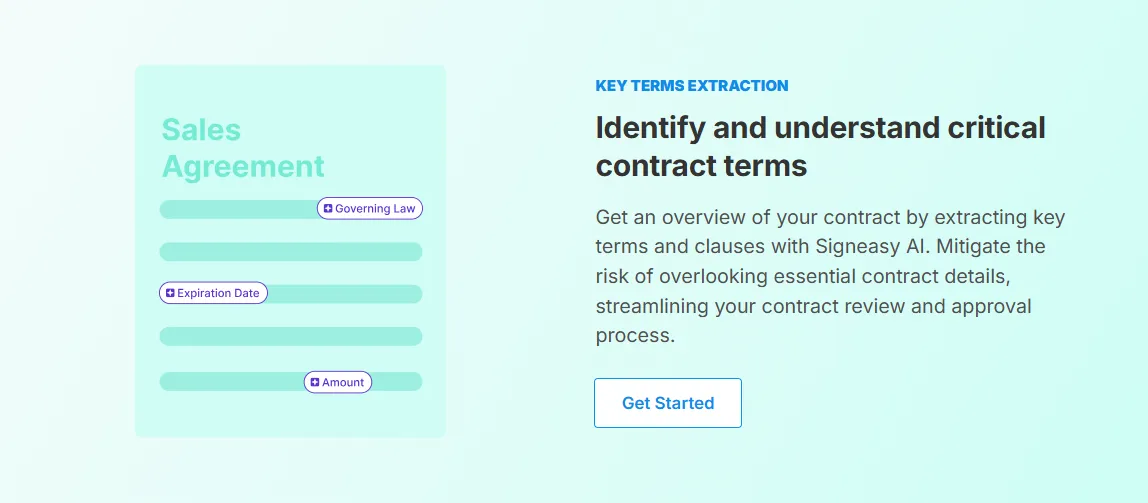
This lets you include a clear, factual snapshot inside your reports, without scrolling through long documents or legal text. With everyone aligned on the same essential information, approvals move faster and compliance becomes easier to track.
4. Compliance status
Compliance status shows whether the contract meets legal, regulatory, and internal policy requirements.
Here, you can include any flagged clauses, missing terms, or overdue audits.
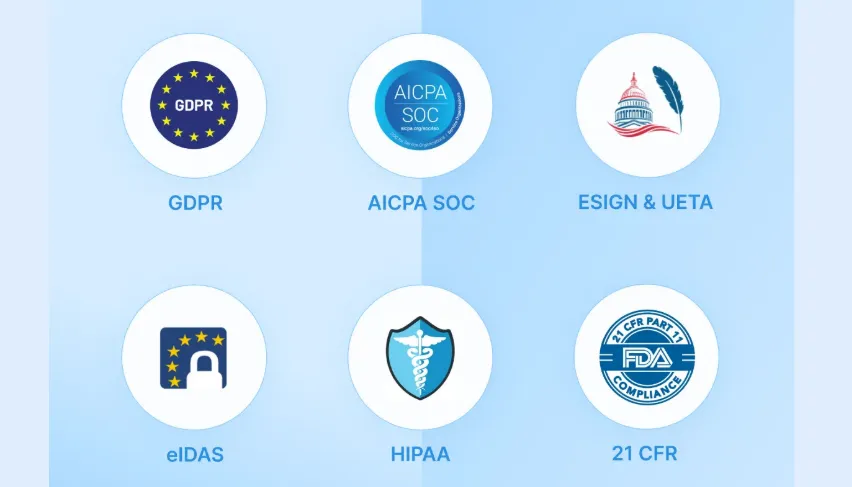
This lets compliance teams catch issues early and avoid these issues from turning into legal or financial risks.
What are the practical applications of contract reporting management?
Contracts reflect vendor behavior, such as whether they deliver on time, overshoot budgets, or miss obligations. Some reveal why your vendor keeps missing deadlines. Others explain why your renewal costs keep creeping up.
Here are five key applications of contract reporting that ensure real business outcomes:
1. Use past contract data to avoid repeat mistakes
Your contract reports are basically a highlight reel of all that has gone right — and all that has gone spectacularly wrong.
So digging into your past contract performance is a great way to start. But reporting is essential for you to do it. With Signeasy’s intelligent contract repository, this is even easier.
It organizes and enriches contracts automatically with no human touch, essentially eliminating errors and helps you:
- Spot recurring compliance failures that keep popping up with certain vendors or contract types.
- Analyze missed deadlines or payments to find if the problem is on your end or the vendor's.
- Track common negotiation delays to streamline future deals and avoid such delays.
These insights help you find reasons behind many issues and avoid them from ever happening again.
2. Improve supplier performance with contract reporting
Your vendors should know exactly where they stand. Contract reporting helps you have those tough conversations backed by data.
It allows you to pinpoint the vendors and how they underperform against the SLA or other terms of the contract. You can even share the details of the underperformance with the vendors. With the right reporting, you can also create performance benchmarks for each vendor.
This enables you to let the underperforming vendors go and bring new ones with confidence.
3. Uncover bottlenecks in the contract lifecycle
If your contracts take forever to get signed, there is usually a specific reason why. Contract reporting can pinpoint exactly where things slow down and its reason.
This enables you to analyze approval process delays and find out where the delays usually happen across the contract lifecycle. You can also find the drafting and review time to identify the types of contracts that take longer than expected — all from an AI-enabled central repository of contracts right within Signeasy.
All these help you figure out the biggest bottlenecks in the process and address them to make contract execution faster.
For example, Calastone, the world’s largest global funds network, used Signeasy to replace their paper-based contract management and signature collection to address the bottleneck of manual contract management.
And here is what the Office Manager, Ourania Gketi, had to say about using Signeasy:
And here is what the Office Manager, Ourania Gketi, had to say about using Signeasy:

You can read more about how Signeasy helped Calastone here.
4. Make smarter renewal and termination decisions
Contract renewal should not ever be like a guessing game. Your contract data can tell you exactly which relationships are worth keeping and which ones need to go.
It allows you to:
- Review contract value trends to see if you are getting better deals over time or not.
- Compare renewal costs vs. benefits using hard numbers instead of gut feelings.
- Renew high-value contracts strategically or cut ties with underperformers.
- Assess supplier reliability records by looking at actual performance data.
This helps you see the impact of the contract on real business outcomes and let go of contracts that don’t really help your business.
5. Reduce risks through proactive contract insights
With efficient reporting, you can flag high-risk clauses early in the contract lifecycle. This means you can negotiate better terms instead of dealing with problems later.
For example, reporting can show you contracts with compliance gaps. More importantly, contract insights can predict potential financial exposure and address it proactively.
But this was always a problem for contract teams as finding information in contracts always took forever. Now with Signeasy’s intelligent contract repository, however, you can find all the details you need in seconds — with search that understands contracts, not just file names.

As a result, you can resolve the gaps before regulatory issues can pop up.
Learn more: Top 10 contract management challenges and how to solve them
Tips and best practices for contract reporting management
Improving your contract reporting management should be a priority for you. It helps you avoid bottlenecks in your reporting efforts and improve visibility into contract performance.
The following tips and best practices can help you do just that:
1. Automate recurring reports
Manual reporting is a productivity killer. Period. Manually updating reports wastes time and increases the chance of missing critical details.
Automating key parts of contract reporting — like renewal alerts or compliance status updates — saves hours every month.
With contract automation in place:
- You get real-time insights, not outdated snapshots
- Deadlines are never missed due to someone forgetting an alert
- Teams can shift focus from admin to strategy
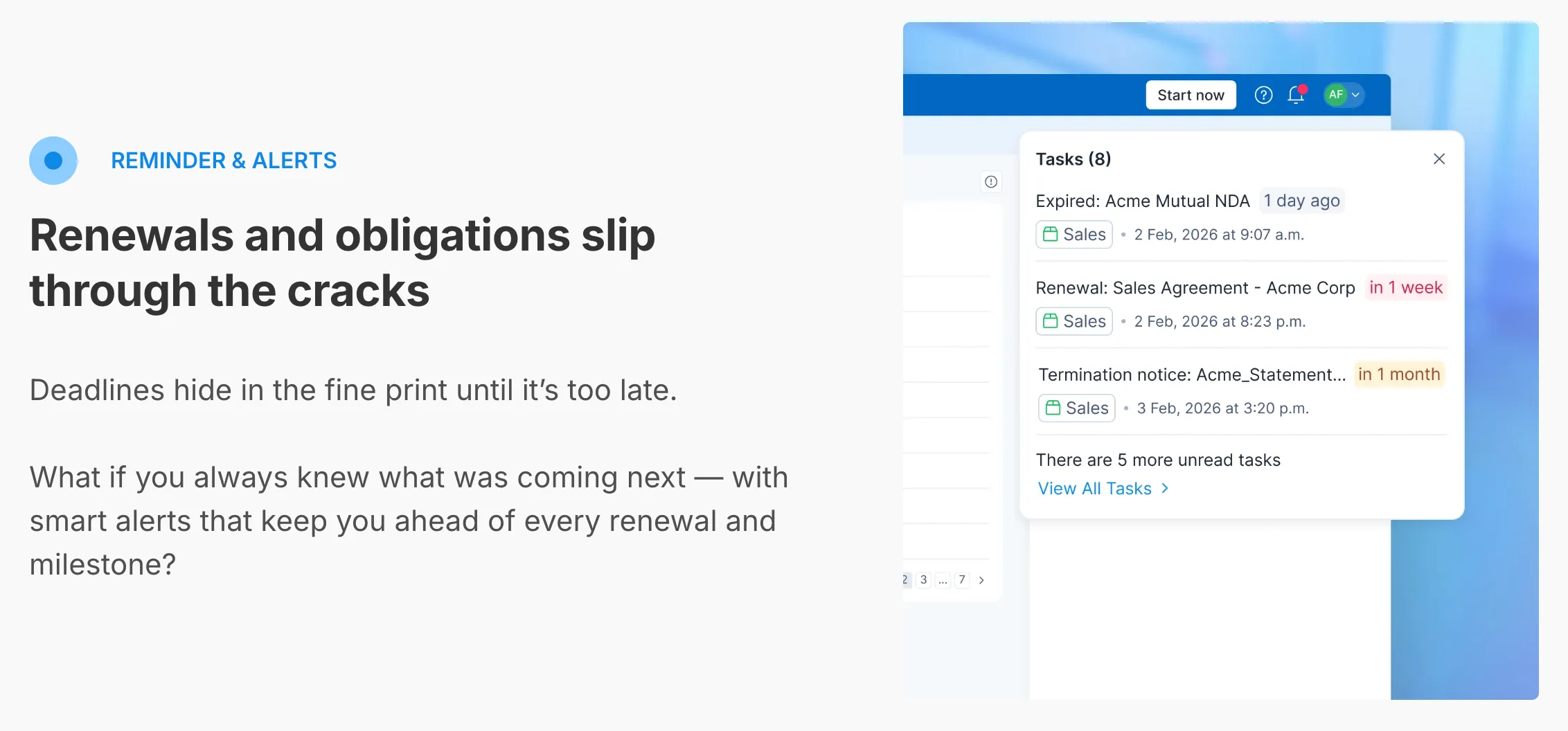
Tools with scheduling and alerting features make this simple to set up and maintain.
2. Standardize all reporting formats
Different departments shouldn't speak different contract languages. Consistency across departments reduces confusion and makes everyone's job easier.
Standardizing formats means faster reviews, easier audits, faster insights, and cleaner comparisons. Create SOPs and checklists to ensure the contracts are standardized. You can also use consistent column headers, naming conventions, and data fields.
3. Define clear KPIs for each contract type
Contracts differ in purpose and impact. Aligning KPIs with each agreement helps track outcomes more accurately and measure value where it truly matters.
For example, vendor contracts need delivery timeline tracking. At the same time, sales contracts should focus on revenue targets. And employment contracts? They must focus on retention metrics.
This targeted approach aligns reporting with business goals instead of generating reports that look impressive but tell you nothing useful.
4. Ensure data accuracy with centralized repositories
When you need contract data, you often need to scour through email inboxes, cloud drives, spreadsheets, and even file cabinets.
That’s mostly the case even if you need just the basic contract details.
You can avoid this ghost-hunting by centralizing contracts into a common repository. While creating the repository, ask the following questions:
- Can all teams access the same, updated contract data?
- Can different teams collaborate on contracts?
- Are duplicate records cleaned up regularly?
- Is audit history easy to access and retrieve?
When the answer is yes to all the above questions, it means you have an efficient contract repository.
What is the role of contract management software in reporting?
Managing contracts with spreadsheets and email chains is a recipe for mismanagement, inefficiency, and errors. Using contract management software can change all this.
Here are five ways it adds value at every stage of the reporting process:
1. It centralizes contracts and reporting data
The last time someone asked for contract details, you may have had to check different folders and email threads to give them the details. And sometimes, you may not be successful in finding the details in time.
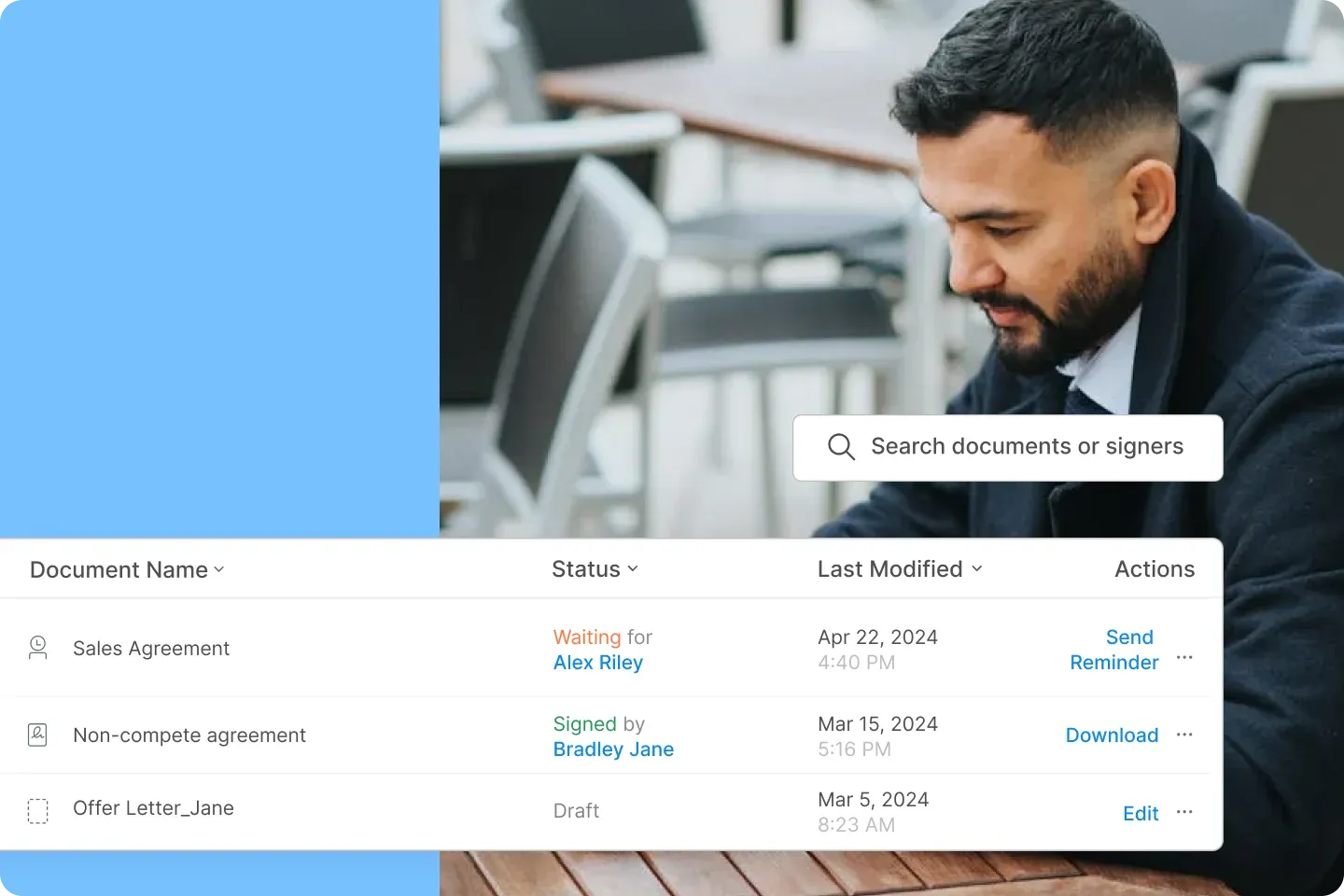
A contract management solution eliminates all that back-and-forth centralizing contracts and reporting data. No more digging or reconciling mismatched documents. It pulls everything into one place — agreements, metadata, audit trails, and reporting fields.
When all your contracts live in one system, you create a single source of truth everyone can trust — just like what Signeasy’s intelligent contract repository does by centralizing every agreement across your organization in one secure hub.
2. It helps automate contract reminders and notifications
Even as someone who manages multiple contracts, your brain is not designed to remember when all 47 contracts expire. That's what software is for.
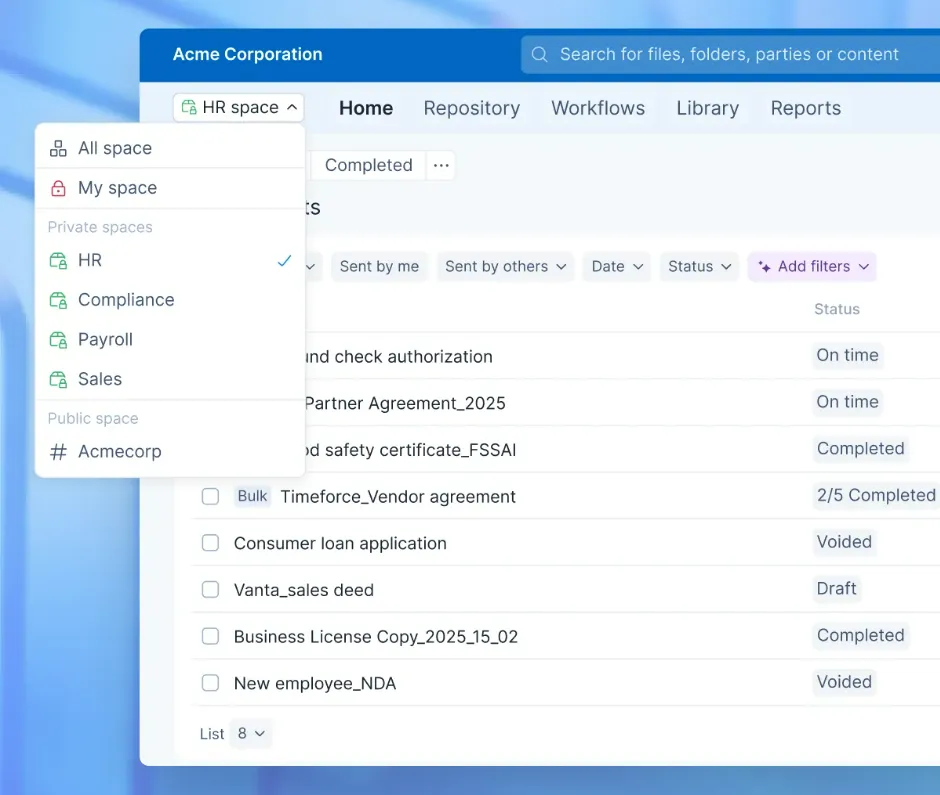
Signeasy’s intelligent contract repository feature makes it even more efficient with smart alerts that let you stay ahead of what’s incoming for you.
And this means that:
- Compliance deadline tracking prevents regulatory surprises
- Renewal notifications arrive weeks before expiration dates
- Payment reminders keep vendor relationships smooth
- Performance review alerts ensure SLAs don't go unnoticed
By automating reminders, teams can stay ahead without needing to track every date manually.
3. It provides real-time insights with dashboards
A good contract management system offers you reliable and data-driven insights that update as your business moves.
These visual dashboards show contract KPIs at a glance, and you can track:
- Contract performance KPIs to see which agreements are crushing it and which need attention
- Team efficiency metrics to track how long approvals take and where bottlenecks hide
- Contract stages and progress to understand exactly where each deal stands in your pipeline
- Financial exposure and opportunities to spot cost-saving chances before they disappear.
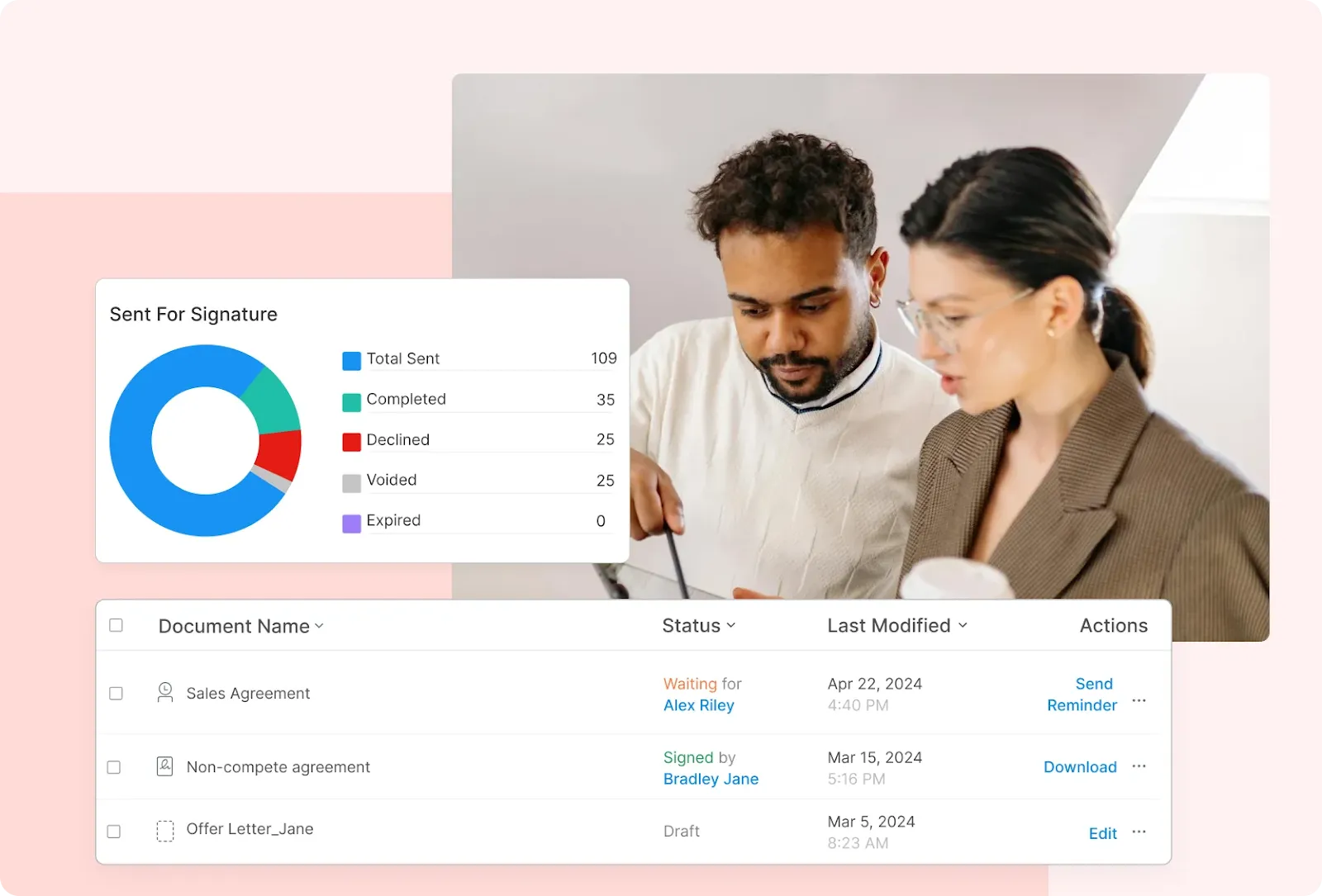
Plus, the software also lets you download and share reports with stakeholders who don't need full dashboard access.
4. It offers integrations with ERP/CRM to ensure unified data
The best contract management software syncs seamlessly with your existing sales and finance systems. And reporting gets better when contract data flows seamlessly between your existing platforms.
It can also help your sales or finance teams to make strategies to drive maximum value from contracts.
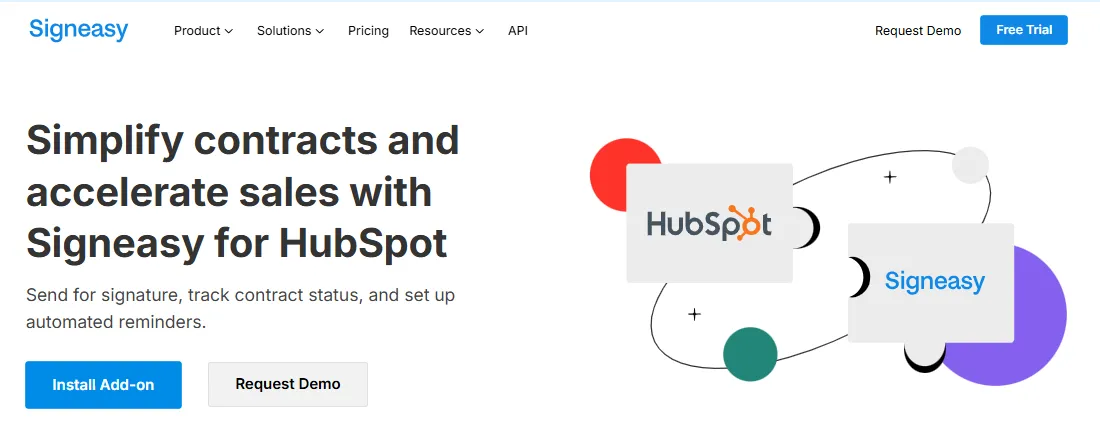
Integrations with tools like HubSpot, or Microsoft Teams offer you diverse benefits, such as:
- Update billing triggers automatically
- Sync contract values with sales forecasts
- Sign and send contracts directly from your favorite apps
This reduces manual entry and makes your reports more connected to real-time business activity.
5. It helps understand contract and compliance gaps with AI
Modern contract management tools, like Signeasy, include AI that extracts key terms, flags risky clauses, or summarizes large agreements.
The AI capabilities help you:
- Improve document drafting
- Detect missing compliance clauses
- Track and notify contract renewal dates
- Spot non-standard terms across a portfolio
- Generate summaries for reports without reading every page
For example, the Founder and CEO of Olto says that the Smart Q&A feature by Signeasy simplifies the task of understanding documents.
Here is what he has to say:
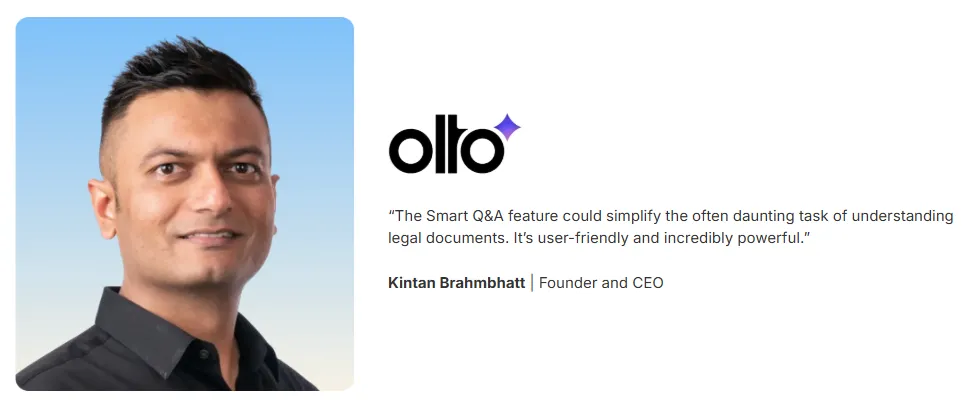
Like this, AI speeds up review time and gives legal or operations teams smarter ways to prioritize contracts based on risk or complexity.
How can Signeasy help improve contract reporting management?
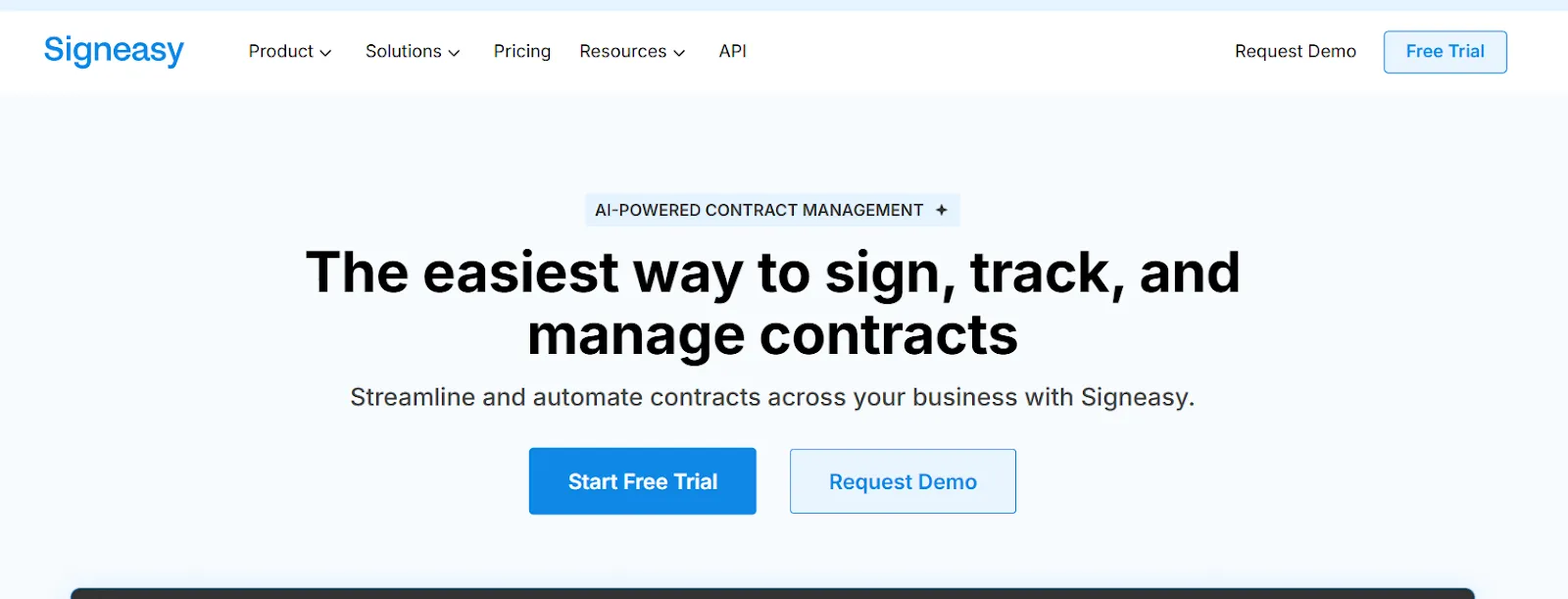
As businesses deal with hundreds of contracts worth millions of dollars, efficient contract reporting is more of a necessity than a choice.
Contract reporting must help stakeholders understand what the contracts bring to the table, how they can be used effectively, what can be done to improve their performance, and how to transform them into revenue-generating assets from mere documents.
These outcomes require the support of reliable contract management software. While there are diverse systems in the market, Signeasy stays ahead of its competitors thanks to its ease of use, AI contract management capabilities, eSignature features, and value delivery.
Apart from this, Signeasy also offers a range of capabilities to help businesses:
- Quickly create and send contracts with reusable templates, envelopes, automated workflows, and fillable fields.
- Organize, search, and discover insights from all your contracts to build a culture of contract intelligence with the intelligent contract repository.
- Template sharing, integrations, and sequential signing to simplify and improve team coordination.
- Send and sign documents faster with legal, secure eSignatures from anywhere, from any device.
- Notify senders, signers, and keep everyone in the loop for streamlined contract management.
- Automate routine tasks and ensure faster completion of contract management tasks without errors.
Are you ready to improve your productivity by 90%? Book a free demo of Signeasy and explore the tool in action.



-min.png)






-min.png)
